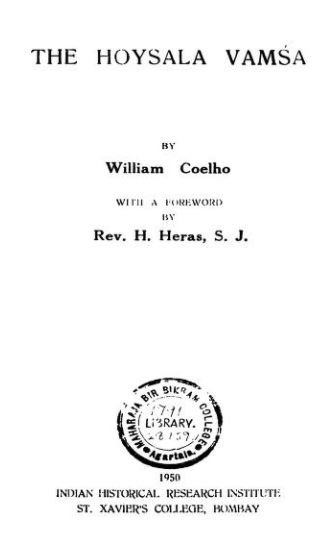‘Hoysala Vamsa’ PDF Quick download link is given at the bottom of this article. You can see the PDF demo, size of the PDF, page numbers, and direct download Free PDF of ‘The Hoysala Vamsa’ using the download button.
The Hoysala Vamsa PDF Free Download

The Origin Of The Hoysalas
Inherently obscure because of its antiquity, the origins of the Hoysala dynasty present a very obscure problem.
on account of two diametrically opposite theories which suggest themselves from tradition and inscriptions.
The first says that the Yadavas are of Hoysala descent, while the second concludes that they were of purely indigenous origin.
Apart from the mythological interest, the term ‘Yadav’ also has real historical significance, and it would be interesting to trace their invasions in the south and their impact on the Dravidian tribes.
The Yadavas belonged to a lunar caste different from the solar caste.
To talk about them is to talk about the early Aryans, because they were none other than the Aryans themselves who first invaded India in prehistoric times.
This suggestion has arisen from the study of Puranas and Vedas as well as ethnography and philology.
Shri C.V. Vaidya quotes Dr. Hornley to say that there were two Aryan races who invaded India at different times and settled in this country.
The first, the long-headed Aryans, settled in the Punjab and Rajputana; while the other, which was broad headed, merged with the Dravidians.
And their descendants are now found from Ambala in the north to Kathiawar in the south-west, Juppulpur in the south-east and Nepal in the north-east.’
Shri Vaidya has identified both these migrations with the two Aryan castes of Sun and Moon.
Although the solar and lunar races were first mentioned in the epics, there is ample evidence of the Aryan invasion in the Vedas, which are clearly contemporary writings.
By the time the epics were written the Aryan invasions would have been a thing of the past and naturally the tradition was wrapped in myths attributing supernatural lineage to the then ruling kings.
Inscriptions claim that Poyasajas was “lord of the excellent city of Dvaravati”, again pointing to the Purtias, where Chrysalija is said to have founded the city of Dvaraka in Aujarat.
The claim first appears in the Hoysaja inscriptions at the end of the 11th century, when the city of Dorasamudra was laid under the patronage of Vinayaditya and Ereyanga.
The Hoysajas first recorded their presence in the 11th century under Nripa Kama Hoysaja.
The founder of their dynasty is said to be Saja and he appears to have ruled probably towards the end of the 10th century. This point will be discussed in the next chapter.
The first Hoysjas were, as would later prove, natives of Ahgadi on the western Ohatas.
The place was then called Sakakapura or Sosavur where Saja killed the tiger on the orders of Mini.
Muni said; “Poya, saja”, which means: “hit, saja”. From that time onwards Saja and his descendants were known as Poysajas. Iyoya is a Haje Kannada word meaning in modern Kanarese.
The word l*oy ( ) is still used
illiterate people in Mysore and especially in the Western Ghats, where the language is not as refined as in the cities.
It is clear that Haje Kannada was the language of the Hoysaja coup d’état, and that even his forefathers spoke the same language; Because in the inscriptions while mentioning the story of Saja, it is said that Muni said “Poy, Saja” in the language of his country, which meant Shakakpura country on the Western Ghats.
If the Hoysajas had come from the north, as Halebid Kaifiyat says, their language could not have been pure Haje Kannada which is a Dravidian language.
| Author | Willam Coelho |
| Language | English |
| Pages | 326 |
| PDF Size | 21.8 MB |
| Category | Literature |
The Hoysala Vamsa Book PDF Free Download

Any changes kindly email me.